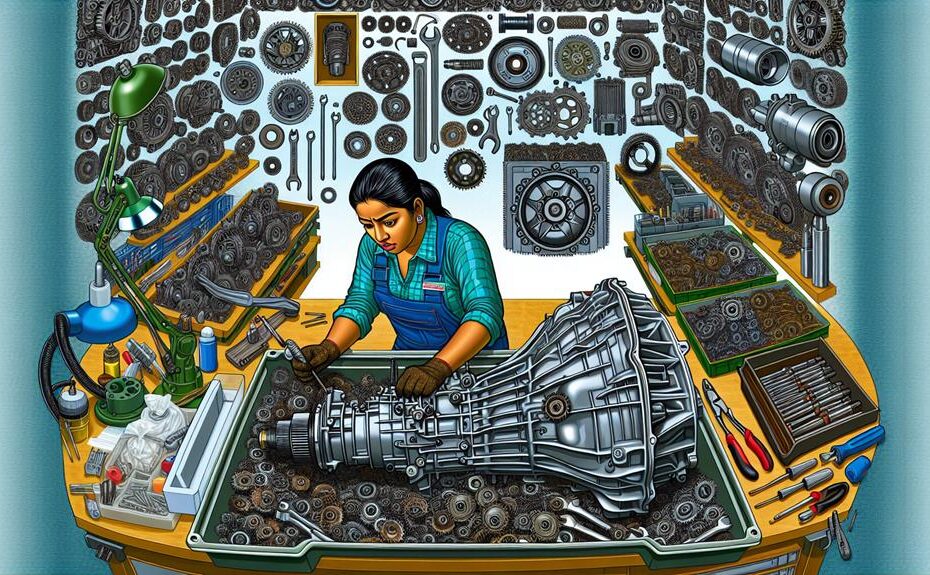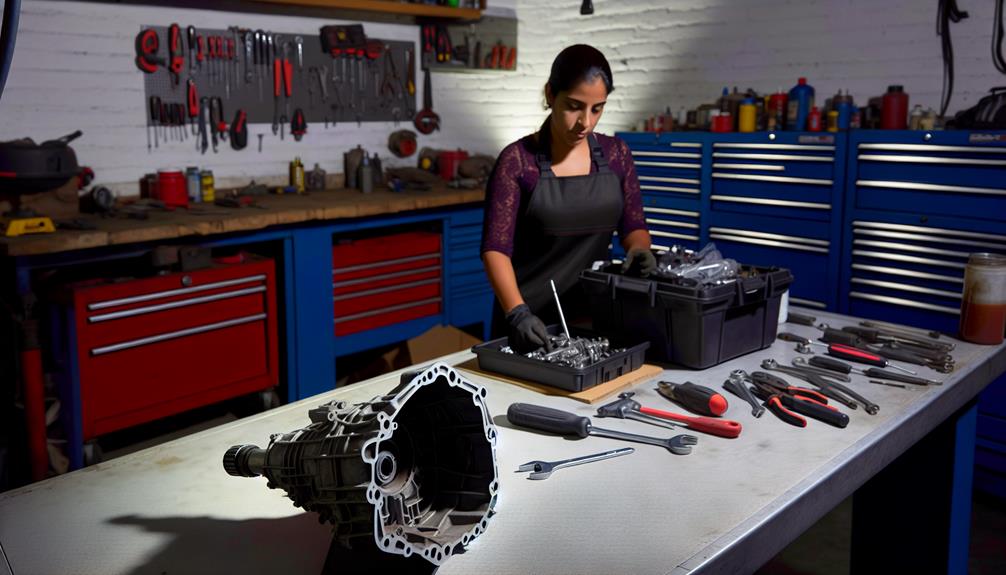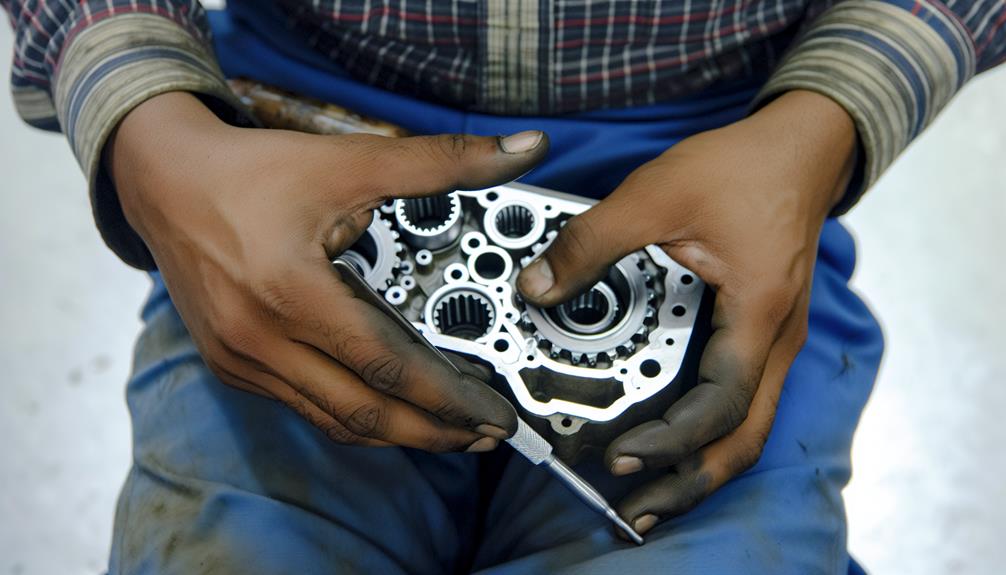You're cruising down the highway, enjoying the smooth ride and the wind in your hair. But suddenly, your car starts to jerk and sputter, leaving you stranded on the side of the road. What could be the cause of this frustrating situation?
Don't worry, because in this step-by-step guide, we'll explain everything you need to know about automatic transmission repair. From identifying common signs of transmission problems to understanding the inner workings of your transmission, we'll walk you through the process of diagnosing and repairing those pesky issues.
So, buckle up and get ready to dive into the world of automatic transmission repair.
Key Takeaways
- Signs of transmission problems include dashboard warning lights, difficulty shifting gears, leaking transmission fluid, and the importance of regular maintenance.
- Understanding the components of an automatic transmission, such as the torque converter, planetary gear sets, valve body, clutches, and bands, is crucial for diagnosing and repairing transmission issues.
- Steps to diagnose transmission issues include checking for slipping gears, conducting a visual inspection of transmission fluid, performing a diagnostic scan, and conducting a road test.
- Common automatic transmission repairs include fluid replacement, solenoid replacement, clutch replacement, and valve body repair. It's important to consider the costs and complexity of the repair before deciding on DIY or professional help.
Common Signs of Transmission Problems
If you're experiencing any of these common signs, it's time to address potential transmission problems. One of the most noticeable indicators of transmission issues is the illumination of transmission warning lights on your dashboard. These warning lights, such as the check engine light or the transmission temperature light, are designed to alert you to potential problems within your transmission system.
It's crucial to pay attention to these warning lights and take immediate action to prevent further damage.
Another sign of transmission problems is difficulty shifting gears. You may notice that your vehicle has trouble getting into gear or that it slips out of gear unexpectedly. This can be a sign of a worn-out clutch or worn transmission bands. Ignoring these issues can lead to more severe transmission damage and costly repairs.
Leaking transmission fluid is another common sign of a transmission problem. Transmission fluid is essential for lubricating and cooling the transmission system. If you notice red or brown fluid pooling underneath your vehicle, it's crucial to address the issue promptly.
To extend the life of your transmission, regular maintenance is essential. Ensure that you follow the manufacturer's recommended service intervals and have your transmission fluid checked and replaced regularly. Additionally, avoid putting excessive strain on your transmission by avoiding sudden acceleration, towing heavy loads, or excessive idling.
Understanding the Components of an Automatic Transmission
Now that you understand the common signs of transmission problems, let's dive into the various components that make up an automatic transmission. Here are the key components you need to know:
- Torque Converter: This component allows the engine to keep running when the vehicle is stopped. It uses automatic transmission fluid (ATF) to transfer power from the engine to the transmission.
- Planetary Gear Sets: These gear sets are responsible for transmitting power from the engine to the wheels. They consist of multiple gears that can be engaged and disengaged to provide different gear ratios.
- Valve Body: The valve body is essentially the brain of the transmission. It controls the flow of ATF to the various components, ensuring smooth shifting and proper operation.
- Clutches and Bands: Clutches and bands are used to engage and disengage different gear sets, allowing for smooth gear changes. They're controlled by hydraulic pressure and are critical for proper transmission operation.
Understanding these components is crucial for diagnosing and repairing automatic transmission issues. If you suspect a problem with your transmission, it's important to check the ATF level and the torque converter operation.
Step-By-Step Guide to Diagnosing Transmission Issues

To diagnose transmission issues, you'll need to follow a step-by-step guide that helps you identify potential problems and determine the necessary repairs. Troubleshooting transmission problems can be a complex task, but with the right approach, you can pinpoint the root cause and take appropriate action.
Start by checking for common transmission issues such as slipping gears, delayed engagement, or strange noises. Conduct a visual inspection of the transmission fluid, looking for signs of contamination or low fluid levels.
Next, perform a diagnostic scan using a transmission code reader to retrieve any error codes that may indicate specific issues. If necessary, conduct a road test to observe the transmission's behavior under different driving conditions. Pay attention to any abnormal vibrations, rough shifting, or fluid leaks.
Additionally, check the transmission cooler and cooler lines for any signs of damage or blockage. Finally, consult your vehicle's service manual for specific tests and procedures that may be required for your particular make and model.
Exploring Common Automatic Transmission Repairs
After diagnosing the transmission issues, it's important to explore common automatic transmission repairs to effectively address the identified problems and restore the optimal functioning of your vehicle. Here are four common repairs that you may encounter:
- Fluid Replacement: One of the most common repairs is the replacement of transmission fluid. Over time, the fluid can become contaminated or degraded, leading to poor performance and potential damage to the transmission. Regularly replacing the fluid can help maintain the integrity of the transmission system.
- Solenoid Replacement: Solenoids are responsible for controlling the flow of fluid within the transmission. If a solenoid fails, it can cause shifting issues or even prevent the transmission from engaging altogether. Replacing faulty solenoids can often resolve these issues.
- Clutch Replacement: The clutch is an essential component that allows the transmission to change gears smoothly. Over time, the clutch can wear out due to constant use. If you experience slipping or difficulty shifting gears, a clutch replacement may be necessary.
- Valve Body Repair: The valve body is responsible for directing the flow of fluid to different components within the transmission. If it becomes damaged or clogged, it can cause shifting problems or even complete transmission failure. Repairing or replacing the valve body can restore proper function.
When considering transmission repairs, it's important to factor in the costs. DIY transmission repairs may be an option for those with mechanical experience, as it can save on labor costs. However, it's crucial to consider the complexity of the repair and the potential risks involved. In some cases, it may be best to seek professional help to ensure the repair is done correctly and avoid further damage.
Tips for Maintaining a Healthy Transmission

To maintain a healthy transmission, it's crucial to follow proper maintenance routines and adhere to recommended guidelines. Regular maintenance is key to preventing major transmission issues and ensuring optimal performance.
One important aspect of transmission maintenance is checking and changing the transmission fluid. Transmission fluid acts as a lubricant and helps in cooling the transmission system. Over time, the fluid can become dirty or contaminated, leading to decreased performance and potential damage to the transmission. It's recommended to check the transmission fluid regularly and change it as per the manufacturer's guidelines.
Another important tip for maintaining a healthy transmission is to avoid excessive heat buildup. Heat is one of the main contributors to transmission failure. To prevent overheating, ensure that the cooling system is functioning properly and that the transmission isn't being overworked, especially when towing heavy loads.
Additionally, it's important to drive the vehicle responsibly and avoid sudden accelerations or aggressive driving, as this can put unnecessary strain on the transmission.
Frequently Asked Questions
How Much Does It Cost to Repair an Automatic Transmission?
Repairing an automatic transmission can vary in cost depending on the extent of the damage and the repair options available. Signs of transmission damage include slipping gears, delays in shifting, and fluid leaks.
Can I Repair My Automatic Transmission Myself?
Yes, you can repair your automatic transmission yourself. With proper knowledge and tools, you can perform maintenance and fix common transmission problems. Save money and gain the satisfaction of doing it yourself.
What Should I Do if My Transmission Fluid Is Leaking?
If your transmission fluid is leaking, it's important to take action. Check the color of the fluid and identify the source of the leak. Common causes include worn seals, loose bolts, or a damaged transmission pan. Addressing the issue promptly can prevent further damage.
How Often Should I Change My Transmission Fluid?
You should change your transmission fluid every 30,000-60,000 miles or as recommended by your vehicle's manufacturer. Neglecting transmission fluid maintenance can lead to low fluid levels, causing damage to your transmission.
How Long Does It Take to Repair an Automatic Transmission?
To repair an automatic transmission, it can take several hours to several days depending on the extent of the damage and the availability of parts. Common causes of automatic transmission failure include overheating and lack of maintenance.
Conclusion
Congratulations! You're now equipped with the knowledge to tackle automatic transmission repairs like a pro.
By understanding the common signs of transmission problems, the intricate components of an automatic transmission, and following our step-by-step guide for diagnosing and repairing issues, you can ensure a healthy transmission for your vehicle.
Remember to maintain regular maintenance and care to keep your transmission running smoothly, like a well-oiled machine.
Drive confidently, knowing you have the power to conquer any transmission challenge that comes your way.
- How to Easily Turn off Interior Lights in Volkswagen Tiguan 2021 - May 12, 2024
- How to Easily Defog Windshield Without AC: Quick Solutions - May 12, 2024
- How Big is 1.2 Cubic Feet: The Ultimate Guide to Measuring Volume - May 12, 2024



